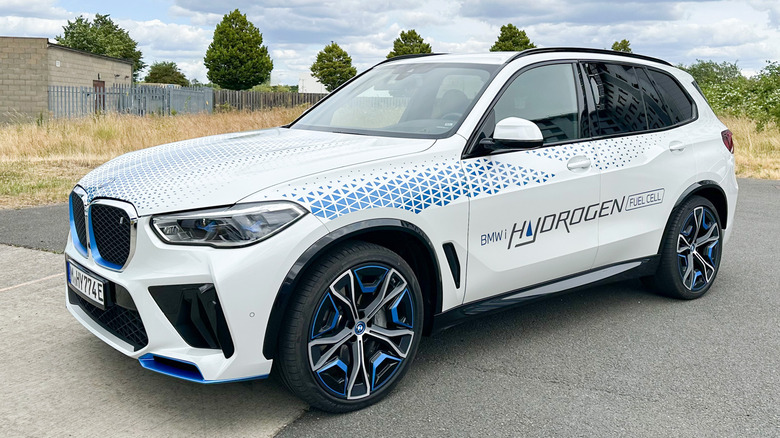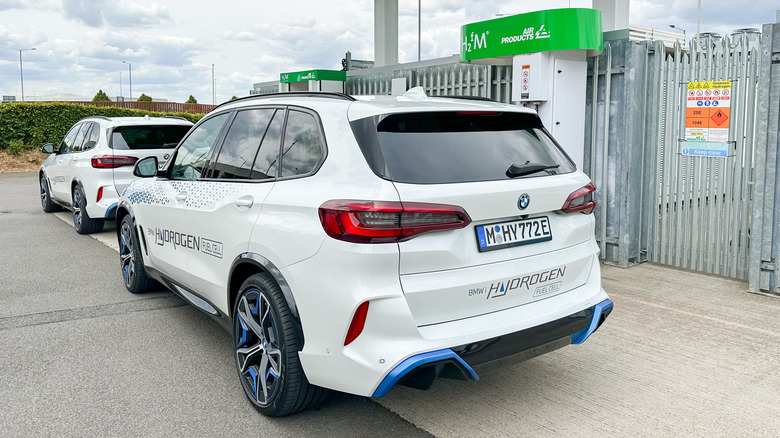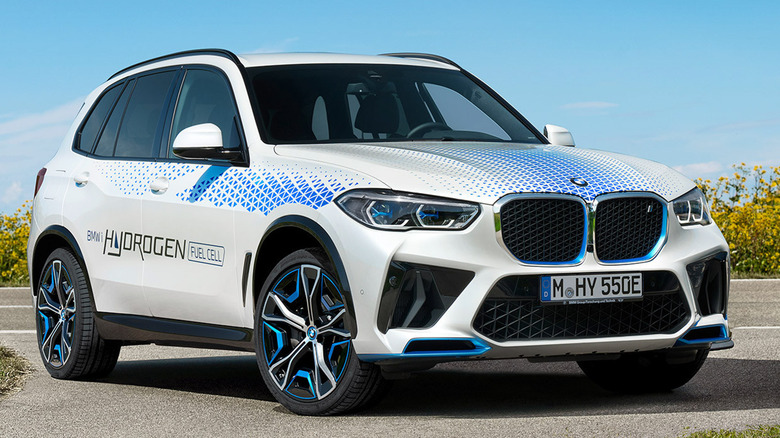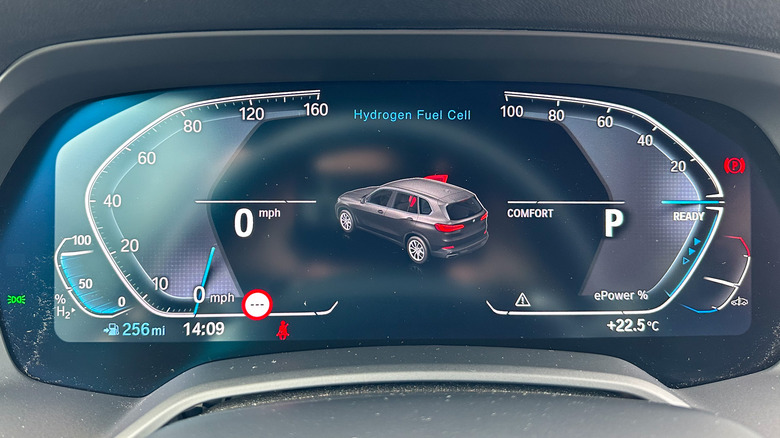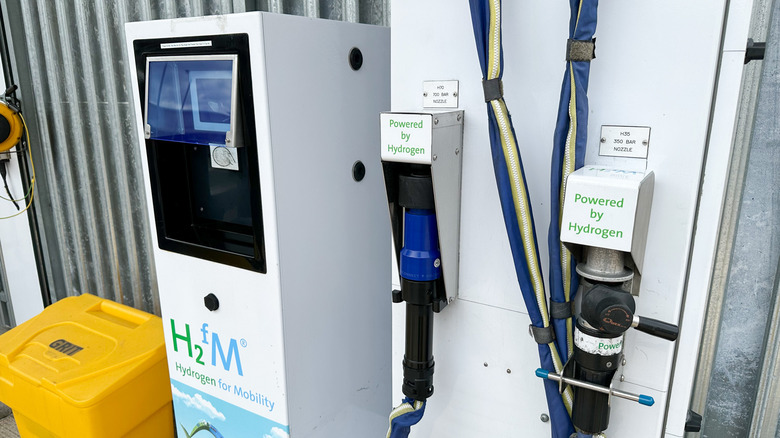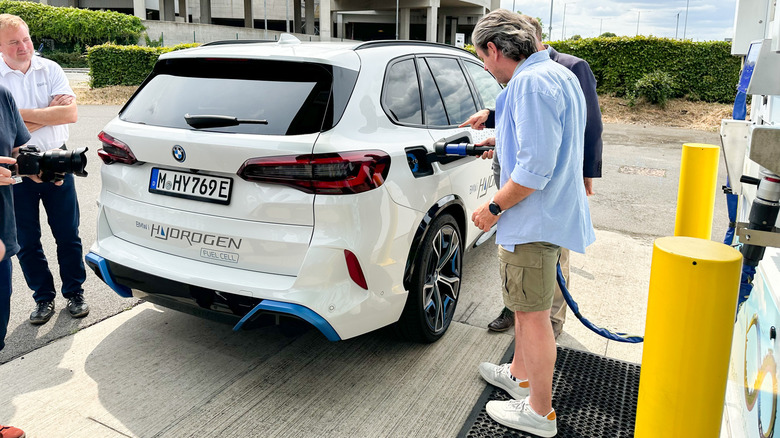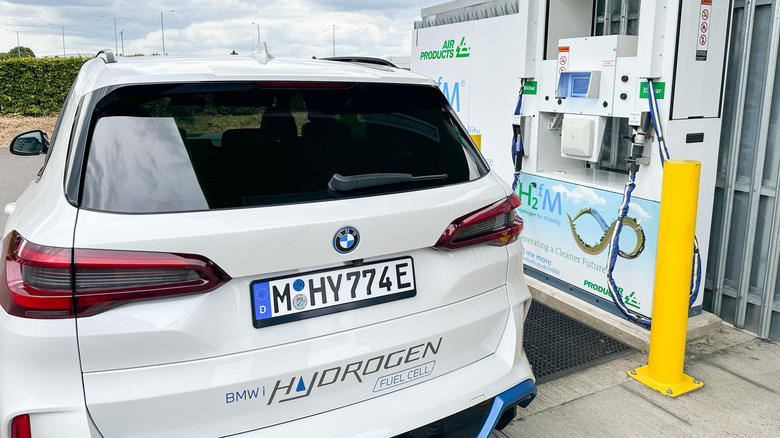2023 BMW iX5 Hydrogen First Drive: It's An EV From A Parallel Universe
Imagine a parallel universe where vehicles using internal combustion are soon to be outlawed, their polluting engines replaced by electric motors just as they are here on Earth. These motors are compact, powerful and highly efficient but, unlike those we're familiar with, they aren't powered by big, heavy onboard batteries.
Instead they draw on electricity created by a miniature power station, itself fed by hydrogen stored in a tank and oxygen captured from the air outside. Just a few gallons in capacity, the tank is filled in a minute or so from a pump at the site of a former roadside gas station. Also used to power trucks and other large vehicles, this fuel gives the electric car a range of about 310 miles and the only emission is water.
This is the parallel universe BMW is attempting to build with its iX5 Hydrogen, an electric SUV currently being tested around the world to see if hydrogen is a plausible alternative to battery-powered vehicles.
To be clear, this is not BMW trying to prove hydrogen is better than batteries. Instead it wants to determine whether there's space in the future car market for both fuel sources. One for the majority of us and our everyday needs, in the form of batteries, and one for those who need to cover a lot of miles, haul a lot of weight, or both.
A long time coming
BMW revealed its first hydrogen concept car back in 2019, then pulled the covers off the iX5 Hydrogen you see here two years later, at the IAA Mobility 2021 in Munich, Germany. Another two years after that, and the company is now ready to begin testing a fleet of about 100 iX5 Hydrogens on public roads.
As you might recall, BMW took a similar approach to EVs with a fleet of electric Minis all the way back in 2009, four years before the company's first electric car, the i3, went on sale to the public. So, while the iX5 Hydrogen driven here looks and feels like the real deal, you won't be able to buy one for quite some time, if ever. BMW has just completed four years of testing hydrogen vehicles across Europe, and will now use the iX5 Hydrogen fleet in testing worldwide.
BMW describes the car as an EV with fast refueling. It also says betting everything on battery-powered electric cars would be like standing on one leg: possible, but not the best long-term solution. Instead it wants to use both legs, and is confident one of those could be powered by hydrogen. The company is also at pains to stress how hydrogen EVs and BEVs (battery electric vehicles) should not be seen as competitors. They are just different ways of reaching the same environmental goal — providing both fuels are produced sustainably, which isn't always the case.
First, the car itself
I don't need to spend too long telling you about the car, because it drives exactly like any other electric car you've ever driven. There's a motor powering each axle and a total system output of 401 horsepower. It has a claimed 0-62 mph time of under 6.0 seconds and a claimed top speed greater than 111 mph. The motors are driven by a tiny, 2.5kWh li-ion battery which is constantly topped-up with electricity produced by the hydrogen fuel cell.
After a few hours both behind the wheel and riding as a passenger I can report it wallows a bit at low speeds, but tightens up nicely in that typical BMW way once you're out of urban traffic. It is quiet, comfortable and refined, just as you would expect from a mid-size BMW SUV that normally costs from around $65,000 when powered by an engine.
Blue highlights on the exterior and interior help to distinguish this from the regular X5 — along with the big 'Hydrogen' stickers, of course — while the digital driver display shows estimated range and percentage of hydrogen remaining in the tank. That has a capacity of 13.2 pounds, since the gas is measured in weight instead of volume. The fuel flap is in its usual place, on the rear right-hand corner.
The benefits of hydrogen
Why should car manufacturers should even consider hydrogen in the first place? The primary benefit is refueling time. As the iX5 Hydrogen demonstrates, a car with a claimed 310 miles of range can be fueled in around three to four minutes. This isn't yet possible with any production battery electric vehicle (BEV).
Most drivers don't need to drive 300 miles, quickly refill the tank, then drive 300 more. But the argument is that because some do — taxi drivers, for example — then they should be catered for with an electric car that suits their needs.
Similarly, installing electric charging infrastructure is more difficult in some places than others, owing to the capability and reliability of the local electricity grid. Hydrogen is delivered to fuelling stations in the same way gas and diesel is today, which could be hugely beneficial in countries yet to build EV charging stations.
Hydrogen electric cars are not affected by cold weather in the same way battery-powered EVs are. Their range does not fall during winter months. They also do not weigh as much as equivalent BEVs, and are better suited to customers who frequently tow trailers long distances, says BMW.
But then there's the fueling network, or lack of it
Time for the elephant in the room. There are currently very, very few hydrogen fueling stations. We're talking around 100 nationwide in the U.S., with almost all of those in California. This situation is repeated in Europe, while in the U.K., where this first drive took place, there are just 15 stations.
These tiny numbers are expected to grow, however, with a few thousand planned for the U.S. alone by 2030. Also by 2030, the EU hopes to have at least one station every 120 miles, totaling over 600 stations. These will predominantly be used by hydrogen trucks, like those currently being developed by the likes of Volvo and Toyota, and buses too.
Stations are usually available for all types of hydrogen fuel cell vehicles to use, so potential iX5 Hydrogen drivers will find themselves lining up among trucks, buses and the like, as well as other cars. BMW is confident that hydrogen fuel station networks will grow to support trucks and buses, and that they'll be accessible for cars too — thus the hydrogen chicken-and-egg problem could be solved.
It's important to understand that not all hydrogen is created equal. The fuel is made by separating hydrogen from oxygen in water using an electric current in a process called electrolysis. Only when the electricity is obtained from renewable sources — solar, wind, hydro, etc. — is the fuel is called green hydrogen.
How refueling works
My first drive of the BMW iX5 included a stop at a hydrogen fueling station near London's Heathrow airport. Operated by a firm called Air Products, it opened in 2012 to fuel a fleet of hydrogen-powered taxis used in a trial during that year's London Olympic Games.
Now used by trucks and buses, it dispenses about 200 kg (440 lbs) of hydrogen per day through two pumps, with 1kg currently costing about £20 ($25.84). Given the BMW has a 6kg (13.2 lbs) capacity, that means its range of 310 miles will cost about $155. Not cheap, but these are very early days for hydrogen and the car isn't yet available to buy.
The hydrogen is stored at 500 bars of pressure in a tank with a capacity of 700 kg (1,500 lbs). It can then be pumped at up to 1,000 bar, so two vehicles can be fueled at once, albeit below the 700 bar maximum rate hydrogen cars like the BMW iX5 are capable of.
The pumps look and feel a lot like those from a gas station, but with a mechanism that locks it into place when attached to the car. The whole process can be done one-handed, payment is handled with the tap of a credit card (since there are no staff at this particular station), and it all feels very intuitive.
Is this really the future?
It's too early to say for sure. But what driving the iX5 proved is that the hydrogen fueling infrastructure, although very small, is fully operational. There are fueling stations and they work exactly as you'd want them to. Companies like Air Products are avoiding the early mistakes made by electric charging stations — the need for RFID cards, memberships, apps, etc. — and providing an experience that is quick, clean, and easy. The car itself also works exactly as you'd expect, only with the added benefits of a range that doesn't decrease in cold weather, and fueling speeds that are on par with gas.
The key here is scale. If large vehicles like buses and trucks start using hydrogen en masse then a network of fueling stations will appear whether car drivers are interested or not. For those who are, they'll be greeted with an increasing number of places to refuel. If that scale materializes, then costs — both for the cars and the hydrogen — will surely fall.
Hydrogen isn't a rival to electricity. Instead, it promises to offer a worthy alternative for drivers whose needs aren't met by battery power alone.
